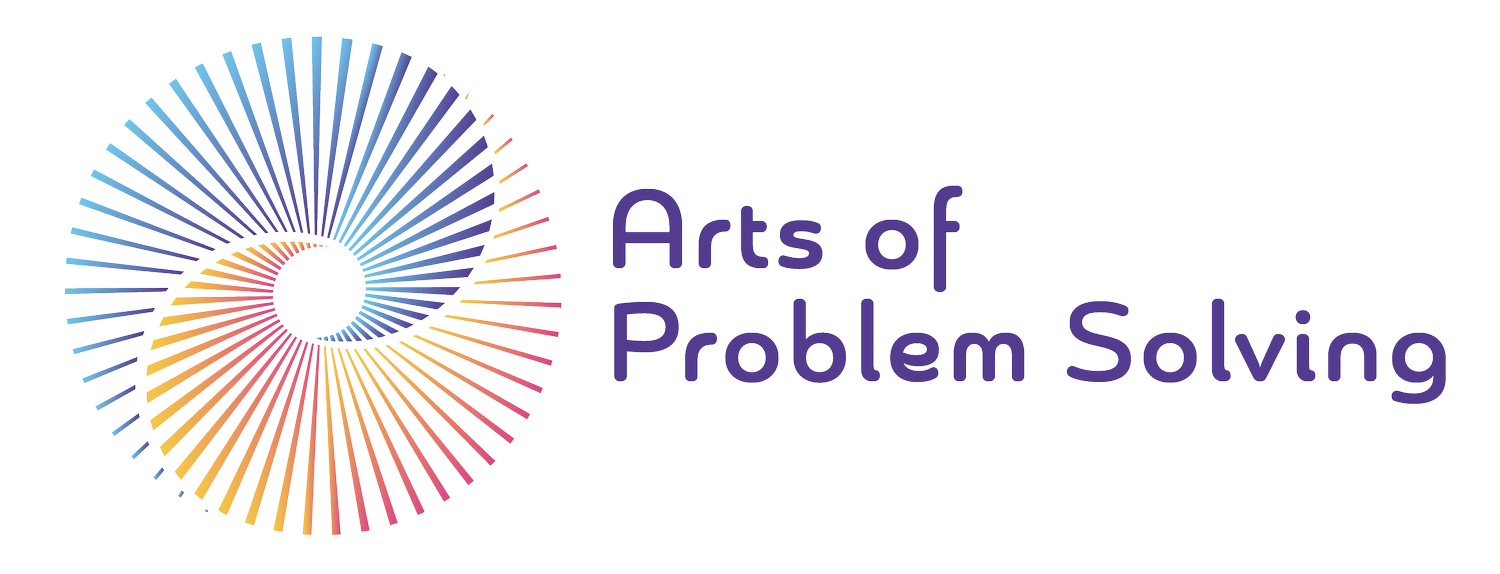
Arts of Problem Solving
Where creative thinking meets bold action to address wicked problems … the ones that don’t have easy answers
AOPS (Arts of Problem Solving) is the strategic frame I, Leila Rao, created to help organizations meet complexity with coherence. It reflects how I approach challenge: not as something to reduce, but as something to engage — purposefully, collaboratively, and creatively.
AOPS brings together the patterns I’ve seen across years of work in agile transformation, systems thinking, cultural strategy, and improvisation. It’s the synthesis of how I’ve helped organizations see differently, decide differently, and ultimately move differently. AOPS supports leaders in thinking more expansively and acting more intentionally — unlocking options that matter and sustaining progress across change.
What sets AOPS apart is how deeply it’s grounded in my own professional journey as a career changer, from my beginnings as newspaper reporter, to working as a healthcare analyst, then as a lean practioner and then into the agile space and finally, this unique space as a trusted advisor and change agent. It’s something I’ve developed through decades of practice helping organizations shift how they navigate uncertainty and complexity.
What Makes AOPS Different?
Each of the three principles below reflects how I approach strategy and design in real environments — as field-tested practice.
Layering Expertise Across Disciplines
My work starts by expanding how organizations understand problems. I’ve learned that the most strategic moves begin with asking better questions — the kind that reveal what’s actually at stake. With AOPS, I create space to surface the assumptions, beliefs, and blind spots that shape perception — and to replace static framing with more generative inquiry.
Whether through visual thinking, wicked agility, or improvisational strategy, expanding perspectives is always the first move in my book, and therefore my work.
Expanding Perspectives
I’ve never believed in staying within disciplinary lanes, which used to be called lack of focus :) AOPS reflects my commitment to drawing from design, behavioral science, improv, systems, and communication strategy — because the work requires it. Because the complexity and challenge facing organizations today requires a truly multi-disciplinary approach to exploring the problem solve and envisioning different.
This is how I think strategically: by layering, not limiting.
Adapting to Complexity Through Collaboration
Everything I do is designed to invite co-creation at the strategic level. AOPS reflects my belief that collaboration is the key to complexity — not compliance, not control. I bring together the right people, the right questions, and the right structures to help organizations iterate toward coherence.
This is more than team-building. It’s strategic alignment through collaborative intelligence — something I’ve facilitated again and again in high-stakes, high-change environments.
Who am I?
My name is Leila Rao! I’ve always been drawn to how people make sense of the world—the choices they make, the systems they build, the unseen forces that shape what they do. Some of that comes from reading widely, some from working across different industries and cultures, and some from simply paying attention to the details most people overlook.
Some people navigate the world through places or moments—I navigate through books, words, and systems. I’ve always been fascinated by how people think, how language shapes perception, and how structures influence choices. That curiosity led me to my work, where I help organizations untangle complexity, improve decision-making, and build cultures of agility and trust.
I don’t believe in easy answers, but I do believe in asking better questions—ones that push past assumptions and reveal the real problem underneath. Whether in a conversation, a piece of writing, or an organizational challenge, I look for the patterns behind the noise, the structure beneath the surface.
Learn more about me at Leila-Rao.com
The AOPS Advantage
This is the same approach I bring to every engagement: helping organizations pause the default response and engage with complexity in a way that’s actionable, aligned, and sustainable.
The organizations I work with want more than short-term wins — they want to build long-term capacity to respond well. AOPS supports that by expanding the space for strategic insight and offering a structured way to connect decisions with outcomes. Here’s what I help unlock:
Accelerated Innovation: I use AOPS to introduce the kinds of questions and inputs that drive creative leaps — not just iteration. This isn’t about “more ideas.” It’s about higher-quality, better-aligned ideas that emerge from an expanded view.
Stronger Decision-Making: I’ve designed AOPS to layer insight and illuminate tradeoffs — so leaders can make grounded, flexible decisions with full awareness of their context and consequences.
Sustained Growth: This is what my work is ultimately about: building the capacity for meaningful change. I’ve helped organizations rewire how they define value and track progress — not by adopting new tools, but by making new thinking visible and actionable.
AOPS thrives in complexity, turning ambiguity into a source of strength. Imagine an organization grappling with a challenge that feels intangible—a combination of shifting priorities, conflicting viewpoints, and uncertain outcomes. AOPS works by focusing on what’s actionable and layering those actions to create momentum. Here’s what this looks like in real use — drawn directly from how I apply AOPS in organizations navigating complexity, conflict, or transformation.
AOPS in Action
Building a Shared View of the Landscape
I design visual frameworks that reveal interdependencies and make complexity visible — not to oversimplify, but to orient. I’ve used this approach to map entire portfolios, connect siloed initiatives, and help leadership teams align without flattening nuance.
Leveraging Adaptive Decision-Making
I’ve embedded adaptive decision-making into every level of my work — not as a reaction, but as a designed capability. Through AOPS, I help organizations treat decisions as strategic inputs — fluid, informed, and directionally aligned. For instance, an organization experimenting with new pricing models might shift strategies based on real-time feedback loops, enabling quick pivots without losing focus on the larger strategy.
Testing Scenarios in Parallel
In my work, I rarely propose a single-track approach. I use AOPS to help organizations explore multiple moves in parallel — from policy shifts to cultural signals to operational experiments. It reflects how I think: layered action > linear strategy.
Aligning Action with Value
This is central to my practice. Whether I’m impact mapping, facilitating cultural transformation, or designing organizational shifts, I focus on linking every action to a defined outcome. AOPS makes that visible — not through theoretical ROI, but by co-creating clarity on what value means and how it’s realized.

Shaping the Future with AOPS
AOPS equips organizations to engage the future with purpose and adaptability. It supports strategic visioning and forward movement by connecting present choices with emerging possibilities.
The future is shaped by what we choose to pay attention to — and how we respond. AOPS provides a structure for intentional exploration, so organizations can evolve confidently while staying grounded in their values, context, and aspirations.
In my work, I use AOPS to support long-horizon thinking and near-term alignment at the same time. It offers clarity in motion — enabling decision-makers to navigate dynamic environments while reinforcing coherence, momentum, and shared purpose.
The future is always unfolding — AOPS helps shape it with clarity, creativity, and care.


